- Stevens - The Institute of Business & Arts (Siba) got it`s start as Patricia Stevens College in 1947. Our campus at 1521 Washington Avenue is located in the heart of St. Louis` revitalized Garment District. Our building was constructed in 1917 for the George E Keith shoe factory.Since our start more than 70 years ago, Siba has been committed to offering small class sizes, individual attention, and expert instructors. Our nurturing environment and adaptability help you develop the skills today`s employers seek in graduates. We strive to make our community accessible to students of all backgrounds by offering a variety of financial aid options. Since our establishment, we have been dedicated to strengthening our region with a committed presence downtown and exceptional graduates.
School Highlights
Stevens-The Institute Of Business & Arts serves 134 students (47% of students are full-time).
The college's student:teacher ratio of 10:1 is lower than the state community college average of 16:1.
Minority enrollment is 78% of the student body (majority Black), which is more than the state average of 41%.
Quick Stats (2025)
- Enrollment: 134 students
- Private-state tuition: $14,580
- Acceptance Rate: 100%
- Student:teacher ratio: 10:1
- Minority enrollment: 78%
- Source: Verified school update
Top Rankings
Stevens-The Institute Of Business & Arts ranks among the top 20% of public schools in Missouri for:
Category
Attribute
Diversity
School Overview
The teacher population of 14 teachers has stayed relatively flat over five years.
Stevens-The Institute Of Business & Arts
(MO) Community College Avg.
Carnegie Classification
Baccalaureate Colleges: Diverse Fields
Baccalaureate Colleges: Diverse Fields
Institution Level
Four or more years
At least 2 but less than 4 years
Institution Control
Private for-profit
Public
Total Faculty
14 staff
139 staff
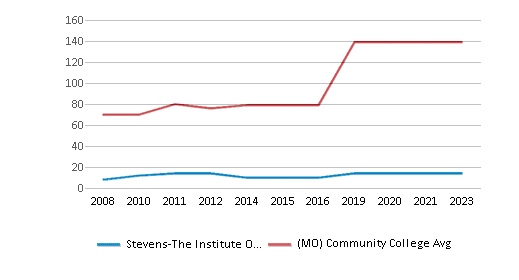
Student Body
The student population of Stevens-The Institute Of Business & Arts has grown by 9% over five years.
The student:teacher ratio of 10:1 has increased from 8:1 over five years.
The Stevens-The Institute Of Business & Arts diversity score of 0.74 is more than the state average of 0.61. The school's diversity has grown by 38% over five years.
Total Enrollment
134 students
1,159 students
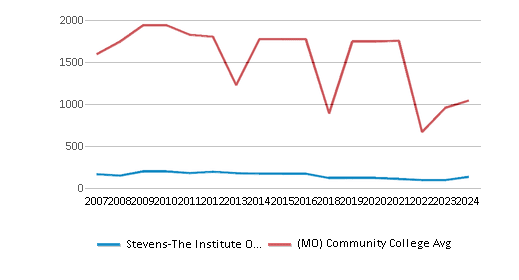
Student : Teacher Ratio
10:1
16:1
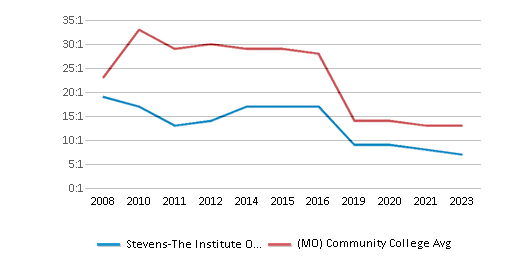
# Full-Time Students
63 students
718 students

# Part-Time Students
71 students
1,407 students
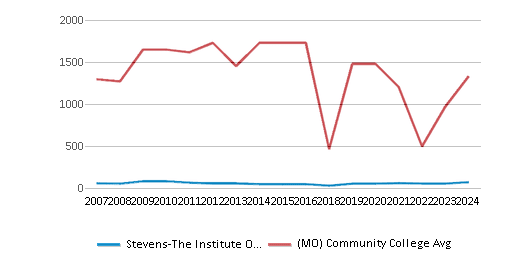


# Enrollment Undergraduate
134 students
246 students
# Full-Time Undergraduate Students
63 students
834 students
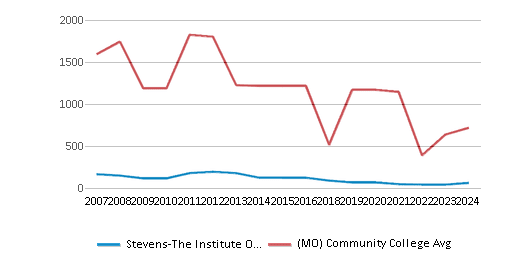
# Full-Time Graduate Students
n/a
11 students
# Part-Time Undergraduate Students
71 students
684 students
# Part-Time Graduate Students
n/a
9 students
Total Dormitory Capacity
n/a
200 students
% Asian
25%
2%

% Hispanic
1%
6%

% Black
37%
10%

% White
22%
59%

% Hawaiian
13%
1%
% Two or more races
n/a
4%

% Non Resident races
1%
1%
% Unknown races
1%
17%


Diversity Score
0.74
0.61

College Completion Rate (Students who graduate in less than 4 years)
50%
36%

College Completion Rate (Students who graduate in 4 years or more than 4 years)
0.8%
0.6154%
Average Graduate Earnings (10 Years)
$27,000
$30,900

Tuition and Acceptance Rate
The private state tuition of $14,580 is less than the state average of $16,263. The private state tuition has grown by 18% over four years.
Private State Tuition Fees
$14,580
$16,263

% Students Receiving Some Financial Aid
91%
91%

Median Debt for Graduates
$26,750
$10,500

Median Debt for Dropouts
$8,473
$5,500

Acceptance Rate
100%
94%

Source: 2024 (or latest year available) Integrated Postsecondary Education Data System (IPEDS) , School Administrators
School Notes
- Stevens Institute of Business & Arts (SIBA) offers a wide variety of programs to study. We offer a 36 month Bachelors' Degree program in Interior Design, Business Administration, Paralegal Studies and Retail Management / Fashion Merchandising. We offer 18 month Associate of Applied Science Degrees in Tourism and Hospitality Management, Interior Design, Business Administration,Paralegal Studies, and Retail Management/Fashion Merchandising. Our average class size is 10-15 students, which allows for plenty of interaction among classmates and instructors. Each faculty member holds a degree related to the classes they teach, and they possess valuable practical experience in their fields. The placement rate for the college's graduates is 90%-100%. Stevens - The Institute of Business & Arts also helps its graduates set up job interviews and instructs them on setting goals, writing resumes, interview skills, and helps them develop professionalism in dress and attitude. Siba is accredited by the Accrediting Council for Independent Colleges and Schools (ACICS) to award certificates, diplomas, Associate in Applied Science degrees and Bachelor of Science and Arts degrees. We have rolling applications/enrollments and applicants must have a high school diploma or a state GED.
Frequently Asked Questions
How much does Stevens-The Institute Of Business & Arts cost?
Stevens-The Institute Of Business & Arts's private state tuition is approximately $14,580.
What is the acceptance rate of Stevens-The Institute Of Business & Arts?
The acceptance rate of Stevens-The Institute Of Business & Arts is 100%, which is higher than the state average of 94%.
What is Stevens-The Institute Of Business & Arts's ranking?
Stevens-The Institute Of Business & Arts ranks among the top 20% of community college in Missouri for: Diversity in US community colleges.
In what neighborhood is Stevens-The Institute Of Business & Arts located?
Stevens-The Institute Of Business & Arts is located in the Downtown West neighborhood of Saint Louis, MO.
Recent Articles

Obtaining Your Bachelor's Degree at a Community College
Explore the evolving landscape of community colleges offering bachelor's degrees, addressing affordability, accessibility, and workforce needs.

A to Z of Community College Certificates and Courses
From business and healthcare to technology and skilled trades, the article showcases the breadth of options available to students seeking to enhance their knowledge, develop new skills, or pursue career advancement.

What is a Community College?
This comprehensive guide explains what a community college is, its history, and its role in higher education. It covers the types of programs offered, differences from four-year colleges, benefits of attending, and important considerations for prospective students, providing valuable insights for those exploring educational options.

















